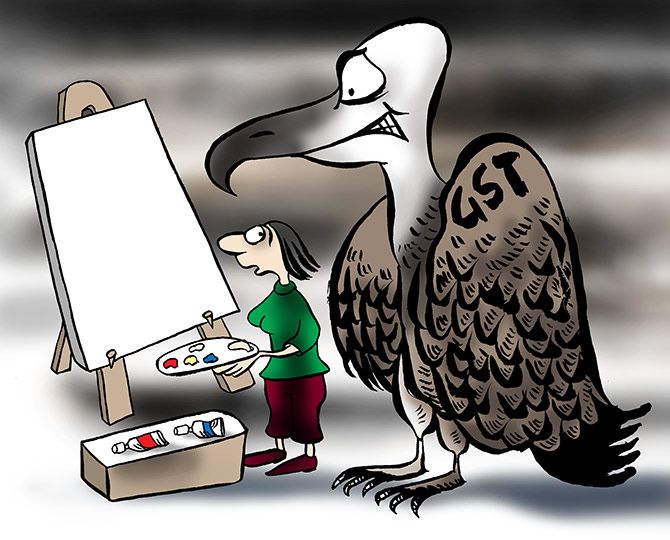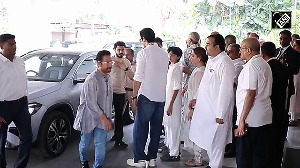Experts said if the slowdown, and subsequent weakness in GST mobilisation, continued, it would curtail the Centre’s resources to a considerable extent in the current financial year.
Illustration: Uttam ghosh/Rediff.com

The slowdown in the economy, which has already resulted in poor growth in the collection of the Goods and Services Tax (GST), is affecting states disproportionately more than the Centre, the data shows.
But, this is no good news for the Centre.
As states have been guaranteed a 14 per cent revenue growth till 2022 under the GST law, the Centre has to bear the entire shortfall in revenue.
Experts said if the slowdown, and subsequent weakness in GST mobilisation, continued, it would curtail the Centre’s resources to a considerable extent in the current financial year.
The data released by the government gives a clear indication of the phenomenon.
Nearly Rs 46,000 crore has been transferred to states from the compensation cess fund in the first four months of FY20 (April – July), registering a growth rate of 140 per cent over the previous year.
In the same period of FY19, the Centre transferred Rs 19,000 crore.
The government collects compensation cess on certain items to fund any shortfall in the states’ GST revenues.
This figure of Rs 46,000 crore in four months is more than 60 per cent of the compensation provided to states in FY19, which is reported to be nearly Rs 80,000 crore, clearly showing a bigger need for compensation in the first few months of FY20.
“This annualises to Rs 1.7 trillion for 2019-20, which is well above the Rs 1.1 trillion budgeted to be collected as compensation cess,” global brokerage Credit Suisse said in a report.
“If the compensation need exceeds the cess collected, the extra funds would go out from general fiscal expenses,” it added.
The picture becomes sharper if we look at how Central GST (CGST) and State GST (SGST) collections have grown or contracted in FY20.
After the distribution of Integrated GST (IGST) to the Centre and states, the central government’s revenue in April-August FY20 has actually been 1 per cent lower than that in the same period of FY19.
The contraction for the states has been sharper - 7 per cent.
This is partly evident from how IGST has been allocated to the Centre (CGST) and the states (SGST of all states).
While there has been an increase of 15 per cent in IGST transfers to the Centre in April-August FY20, IGST transfers to states have contracted 8 per cent in this period.
This has severely reduced the GST revenue accrual to states, compelling the Centre to fill that shortfall using the amount collected as GST compensation cess.
IGST is collected on imports and inter-state transfers, and is distributed among the Centre and states regularly, either by regular settlement based on the knowledge of place of supply or by ad hoc settlement on a 50:50 basis to ease the cash flow to the Centre and the states.
A senior government official, however, said the increased transfer to states from the cess account was due to slower distribution of IGST in this period.
“Due to the slowdown, with respect to states, both the SGST and the IGST components to states are growing slowly.
"In addition, the overall IGST transfer itself (to states and Centre) was low in July, resulting in higher transfers as compensation cess,” he said.
This might also lead to a higher availability in the IGST account at the end of the financial year, if revenue mobilisation increases, he added.
According to a Kotak Securities report, the Centre now needs nearly Rs 50,000 crore a month, while the states need Rs 60,000 crore a month in the remaining eight months of FY20.
The Centre and the states collected Rs 40,000 crore in August 2019, according to the finance ministry.












 © 2025
© 2025